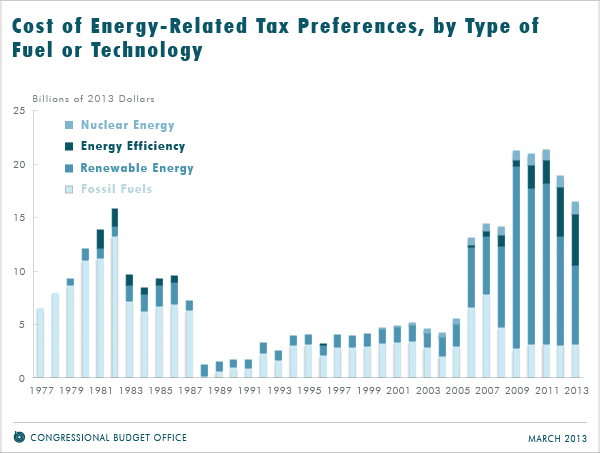This afternoon I testified on federal financial support for fuels and energy technologies before the Subcommittee on Energy of the House Committee on Science, Space, and Technology. My testimony—discussed below—updates a CBO report from 2012 on the same topic.
Federal support for the development and production of fuels and energy technologies totals almost $20 billion in the current fiscal year. Tax preferences account for about 80 percent of that amount, and spending programs administered by the Department of Energy (DOE) account for the remaining 20 percent.
Tax Preferences
I began by discussing tax preferences for fuels and energy technologies. Most of the tax preferences are special tax credits or tax rules that reduce the amount of income or excise taxes that people or businesses pay. As shown in the figure below, for most years until 2005 the largest share of that support went to domestic producers of oil and natural gas. Beginning in 2006, the cost of energy-related tax preferences grew substantially. Moreover, an increasing share of those costs was aimed at encouraging energy efficiency and the use of energy produced from renewable sources, such as wind and the sun, which generally cause less environmental damage than producing energy from fossil fuels.

In 2013, as shown in the figure below, provisions aimed at energy efficiency and renewable energy account for about 3/4 of the estimated budgetary cost of federal energy-related tax preferences. That mix reflects changes to the tax system made by the American Taxpayer Relief Act of 2012, which was enacted in January of this year. That law extended until the end of this calendar year four major tax preferences aimed at increasing energy efficiency and promoting the use of renewable sources of energy.

Under current law, the mix of energy tax preferences will look quite different in the future. That is because most of the support for energy efficiency and renewable energy comes from provisions that have already expired or are scheduled to expire at the end of calendar year 2013. In contrast, most of the support for fossil fuels and nuclear power comes from provisions that are permanent.
The Department of Energy’s Programs
I then discussed DOE’s role in supporting energy technologies—making direct investments in them and by subsidizing or guaranteeing loans. The amount of support has varied over time, but has generally declined in recent years. Measured in 2013 dollars, DOE’s support for energy technologies totaled $10.5 billion in 1980 and is only about one-third as much, or $3.4 billion, in 2013. The notable exception to the trend in DOE support is the spike in 2009, reflecting the funding provided by the economic stimulus legislation, the American Recovery and Reinvestment Act of 2009.
In 2013, more than half of DOE’s support for energy technologies is directed toward energy efficiency and renewable energy, 22 percent is for nuclear energy, and 15 percent is for fossil energy. Most of the spending in each of those categories goes toward applied research and development.
DOE received roughly $10 billion in funding for its subsidized credit programs in 2009 but has received only limited additional subsidy funding for those programs since then: $170 million in 2011 and no new subsidy funding in 2010, 2012, or 2013. Between 2009 and 2012, DOE provided an estimated $4 billion in subsidies for about $25 billion in loans and loan guarantees, primarily to generators of solar power, manufacturers of solar equipment, and producers of advanced vehicles.
Why a Role for the Government?
My remarks ended by discussing the two main economic rationales for the government’s involvement in energy markets:
First, without government intervention, households and businesses do not have a financial incentive to take into account the environmental damage or other costs to the nation associated with their choices about energy production and consumption. The most direct and cost-effective method for addressing that problem would be to levy a tax on energy sources that reflects the environmental costs associated with their production and use. Subsidies (such as tax preferences) for favored technologies can accomplish some of the same goals but in a less cost-effective way.
Second, unless the government intervenes, the amount of certain types of research and development that the private sector undertakes is likely to be inefficiently low from society’s perspective. Such underinvestment is particularly likely for basic research in the early stages of developing a technology. Research at that stage can create fundamental knowledge that can lead to significant benefits for society as a whole but not necessarily for the firms that funded that research; thus government funding can be beneficial. By contrast, DOE’s funding of energy technology demonstration projects at later stages in the development process has been far less cost-effective, and DOE has been criticized for its management of such projects.
Terry Dinan is a senior advisor in CBO’s Microeconomic Studies Division.

